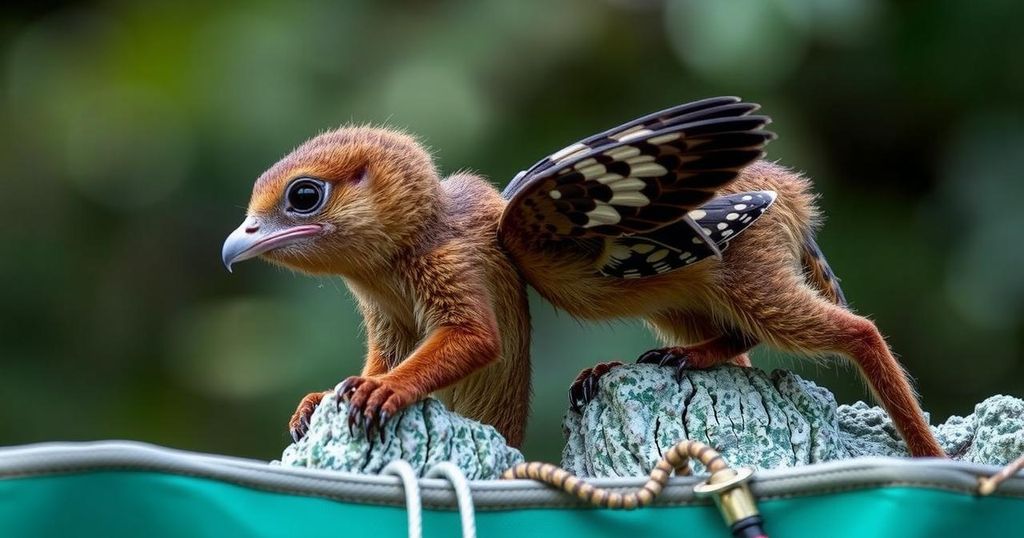The Helmeted Water Toad in Chile, a species that has existed since the time of dinosaurs, is now considered vulnerable due to habitat loss attributed to climate change and human encroachments. With one-third of amphibian species at risk of extinction, urgent conservation efforts are needed to address the ongoing biodiversity crisis while the debate over reviving extinct species through biotech continues.
In a poignant development, the Helmeted Water Toad (Calyptocephalella gayi) from Chile, a species that coexisted with dinosaurs, is now classified as vulnerable by the International Union for Conservation of Nature (IUCN) due to significant population decline driven by human activity and climate change. This amphibian, a living fossil that has persisted for millions of years with minimal genetic alterations, has seen its population decrease by 30% since 1990, largely owing to habitat destruction caused by urbanization and environmental changes. “It’s heartbreaking that a species that outlived the dinosaurs now faces extinction at human hands,” remarked Melissa Cancino, founder of Proyecto Anfibia, a Chilean conservation group dedicated to amphibian research.
The plight of amphibians reflects a broader crisis, with roughly one-third of the planet’s 6,300 amphibian species at risk of extinction. Habitat loss, pollution, invasive species, and disease are major threats, and scientists warn that the decline of these animals may indicate an impending biodiversity crisis. The IUCN’s assessments reveal that 46,300 species across various taxa face extinction, emphasizing urgent conservation needs to prevent further losses. Notably, island species are particularly vulnerable due to habitat fragmentation, which isolates populations and diminishes genetic diversity.
In an alarming trend, scientists project that approximately one million species may become extinct in the coming decades, with current rates of extinction significantly surpassing historical figures. The United Nations warns that the ongoing extinction crisis could rival that which led to the demise of the dinosaurs. Human activities, such as deforestation and pollution, are primary drivers of this crisis. However, advocates for conservation highlight that humanity also holds the potential to reverse these trends. “We are not only the cause but also the solution,” proponents assert, underlining the need for collaborative conservation efforts.
Amidst these conservation discussions emerges a controversial concept: the revival of extinct species. Colossal Biosciences, a biotech startup, is pioneering efforts to resurrect species like the woolly mammoth and Tasmanian tiger through advanced genetic engineering techniques. Their projects aim to reintroduce these species to their historical habitats, thereby restoring ecological balance. Critics caution, however, that the environments these organisms once inhabited have changed drastically, potentially complicating their revival. Nevertheless, proponents argue that the introduction of apex predators like the thylacine could mitigate ecological decline and restore balance in environments that have seen a rise in invasive species and habitat degradation.
The debate continues regarding the allocation of resources toward conserving existing endangered species versus investing in de-extinction projects. Each approach presents unique challenges and potential benefits, and the decision regarding the best course of action requires careful consideration of ecological impacts and ethical considerations in species revival.
The Helmeted Water Toad and similar species are reflecting the ongoing biodiversity crisis caused by human activity, climate change, and habitat loss. This crisis affects amphibians particularly acutely as they serve as ecological indicators and are notably susceptible to environmental changes. The conversation surrounding species conservation vs. de-extinction is increasingly relevant in the context of a potential mass extinction event, raising important ethical questions about how to prioritize biodiversity preservation.
The plight of the Helmeted Water Toad underscores the urgent need for comprehensive conservation efforts as amphibians face unprecedented threats. With one-third of amphibians at risk, scientists advocate for urgent action to mitigate habitat loss and pollution. Concurrently, the debate over reviving extinct species through genetic engineering presents a contentious option that, while potentially beneficial, carries significant ecological considerations. Therefore, a balanced approach that prioritizes both conservation and responsible innovation is vital for preserving the planet’s biodiversity.
Original Source: americanbazaaronline.com






